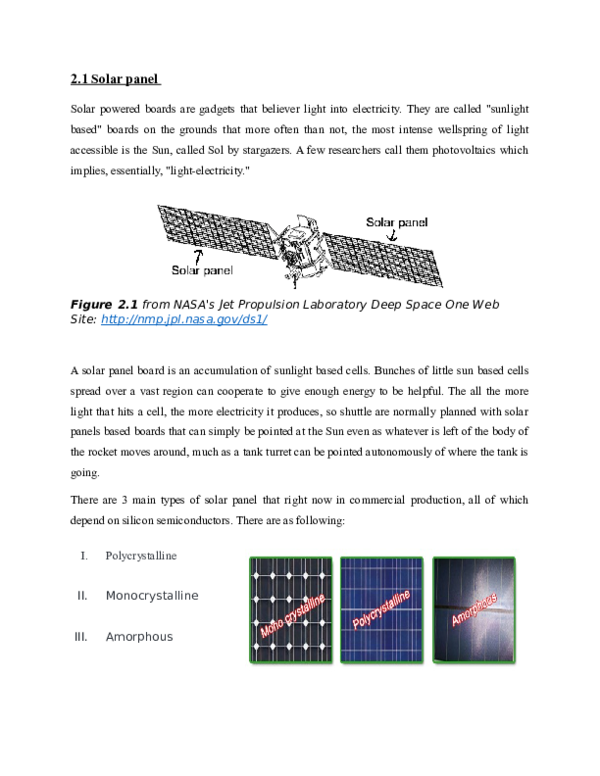Academia.edu no longer supports Internet Explorer.
To browse Academia.edu and the wider internet faster and more securely, please take a few seconds to upgrade your browser.
Solar panel
Related Papers
The sun is the ultimate source of energy. The earth receives incredible amount of solar energy in terms of heat and solar radiation. It provides enough energy to the earth in such a way that it needs one minute to supply the world's energy need in one year. In fact, the amount of solar radiation striking the earth over a three-day period is equivalent to the energy stored in all fossil energy sources [1]. So the solar energy from the sun is source of limitless energy available at no cost [2] i.e. a source of renewable energy. The major benefit of solar energy over other renewable and nonrenewable energies is that the sun light can be easily harvested to solar energy and then other types of energy using a small tiny photovoltaic solar cell. Though the solar energy is a source of freely available energy, there is still an initial expenditure on the equipment for harvesting this radiant energy by developing solar cells, panels and modules [3]. These small and tiny solar cells produce no noise during their operation whereas the big power generating devices produce unbearable sound pollution as well as environmental pollution, and therefore very disturbing to the society [4][3]. Nowadays, due to the decreasing amount of renewable energy resources, the per watt cost of solar energy device has become more important in the last decade, and is definitely set to become economical in the coming years and grow as better technology in terms of both cost and applications [5][6]. In spite of numerous advantages, the solar energy also has some limitations too. Firstly, solar energy from sun can't be obtained during night time. Secondly, the solar energy is almost not constant all the time during the day. There must be plenty of sunlight available to generate electrical energy from a solar PV device [7] [6] [8]. Moreover, apart from daily fluctuations in the intensity of radiant energy, the solar energy is hindered to reach the earth during bad climatic conditions [6] [8]. To overcome these demerits of this technology, solar energy must be stored elsewhere to be used at night and the highly efficient solar cells and modules needs to be developed.
In this technique we put forward step to charge the different types of batteries at a single circuit or product using with solar energy. In today’s environmentally conscious climate there is more and more interest being taken in alternative forms of power supply. Currently there are plans underway for a new Engineering Building for the institute, in which it is hoped that some of these alternative and more environmentally friendly technologies may be incorporated. The purpose of this project is investigate the feasibility of implementing a mobile phone charging system, to be used by students, which is powered by energy generated from solar panels that may be integrated into the fabric of the building. Not only the students, has this circuit useful to different industrial works for charged the batteries. This project involves designing a small scale mobile phone charging system which is powered via a solar panel and that is capable of charging multiple mobile batteries simultaneously and also different chargeable batteries such as lead acid, Ni-cd batteries. The project also requires research into the different solar panels available for the small scale system being designed, as well as into larger solar panels that may be implemented into a building’s design. Investigations will also have to be made into how the overall system would change if these larger solar panels were implemented. The small scale test system will also be able to display information visually to the user of the system regarding the systems overall capacity to charge at any given time and will also include power management functions. It is the purpose of this work to introduce a relatively simple battery charger that can automatically distribute the electric current produced by photovoltaic solar panel in an optimum way to extract the maximum charging current at all times depending on light intensity.
A photovoltaic cell comprising, a cathode layer, an electron donating layer, and an electron accepting anode structure comprising a collection region including one or a plurality of secondary collection regions attached to the collection region. The secondary collection regions of the anode preferably are in the shape of dispersed rod shaped branches extending within a continuous phase of the electron donating layer. The collection region is preferably located at a central point with respect to the secondary collection regions, to thereby provide a photovoltaic cell structure with improved charge collection and efficiency of operation
RELATED PAPERS
The Discreet Charm of Art Forgery, Exhibition catalogue, Teloglion Foundation of Arts, AUTh, February 2–June 16, 2024
TSANGARAKI 2024_THE DISCREET CHARM OF ART FORGERY_Exhibition Catalogue_Entries2024 •
Revista Universidad De Antioquia
Clonación humana y literatura de ciencia ficción: una visión panorámica2007 •
Ελληνική Βιβλική Εταιρία
Η Θεολογία του Αναμεταξύ και η θέση της γυναίκας στην Εκκλησία2020 •
La ceguera de rio
MATERIAL PARA EL ESTUDIANTE MERK Y LA CEGUERA DE RÍO | 12019 •
2020 •
Immunology and infectious diseases
Comparison of Two Phenotypic Double Disc Diffusion Test (DDDT) for Detection of Extended Spectrum β-Lactamase Production by Enterobacteriaceae and Pseudomonas Species at a Tertiary Care Hospital in Bangladesh2015 •
Journal of Biological Chemistry
Oligomerization and Topology of the Golgi Membrane Protein Glucosylceramide Synthase1999 •
East and Central African Journal of Surgery
Thyroid Dysfunction among Young Adults in Uganda2010 •
Innovative Issues and Approaches in Social Sciences
Physical Courage in High- and Non-Risk Athletes2017 •
Orientalistische Literaturzeitung
Fabry, Heinz-Josef / Böhler, Dieter (Hg.): Im Brennpunkt: Die Septuaginta2014 •


 Sritharan Ravichanthiran
Sritharan Ravichanthiran